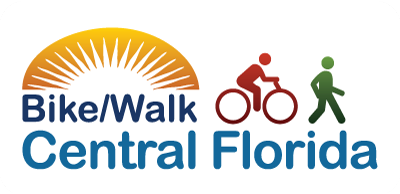Who are these pedestrians anyway? Let’s address common misconceptions about people who walk:
#1. Fewer people walking mean fewer pedestrian deaths.
False. With most people in Orlando traveling by car, you might conclude that fewer people are walking and, therefore, there would be fewer pedestrian fatalities. Unfortunately, that isn’t the case. When pedestrians are not a common sight, drivers don’t watch out for them — and, tragically, aren’t mindful of people on foot when approaching crosswalks or turning into cross streets.

Pedestrians are a common sight on Winter Park’s Park Avenue.
#2. Tourists are the leading cause of pedestrian-vehicular deaths
False. Locals walking alongside or crossing streets in Orlando are the most likely victims of fatal collisions with vehicles According to MetroPlan Orlando, 83% of the pedestrians who were struck and killed by drivers lived in Orange, Seminole or Osceola counties; less than 5% were from other states. The view of tourists behind the wheel being a threat to pedestrians is unsubstantiated, too. More than 70% of the drivers who struck a person walking were locals while 3% were from other states and less than 0.7% were from foreign countries.
#3: Pedestrians are usually older people.
What's the most dangerous state for senior pedestrians? Hint: It's not Florida. #DangerousByDesign https://t.co/doBoGWwGE0 pic.twitter.com/KjKclIothL
— Smart Growth America (@SmartGrowthUSA) January 13, 2017
False. Young people can be found footing it too. According to a study by the U.S. Public Interest Research Group at Rutgers University, millennials are discovering a preference for public transit, biking or walking instead of driving. It is true, however, that nationwide, victims of car/ped fatalities are disproportionately people over 50, possibly because their reflexes may be slower and they are less likely to recover from serious injury than younger people.
#4: Jaywalking is illegal in Florida.
False. Jaywalking is not a legal term and does not appear in Florida laws. Florida Statute 316.130 (10-12) states that pedestrians can cross a street where there is no crosswalk but they must yield to vehicles on the road. In other words, a walker can cross a street almost anywhere on it, but vehicles have the right-of-way if there is no crosswalk.

A couple other rules:
- If pedestrians are between two intersections with working traffic signals, they must walk to one of the two intersections and cross at the crosswalks.
- Pedestrians must cross the street in a straight line, not diagonally.
#5: Pedestrians are them, not me.
Pedestrians aren’t “others” – they’re you, me, parents, neighbors & friends. We’re all pedestrians sometimes & we all deserve to be safe. pic.twitter.com/B086BQp6MX
— Florida PIRG (@Florida_PIRG) January 13, 2017
False. Say you drive into downtown for a concert at Amway Center and park in a garage only a block from the venue. You’re a pedestrian the moment from the moment you leave the driver’s seat. Or maybe you’re going to Target, park your car and walk into the store. You’re a pedestrian.
It doesn’t matter whether you walk from home to work, or only as far as your mailbox. Every step of the way you’re a pedestrian, and you deserve to feel as safe on foot as you do on four wheels.

